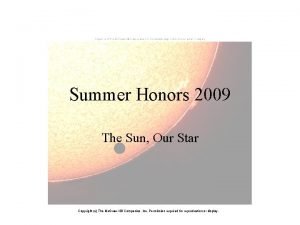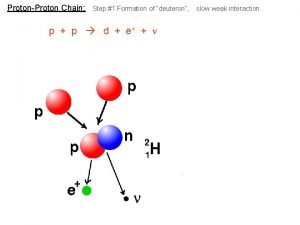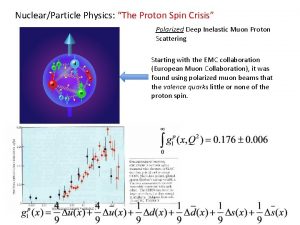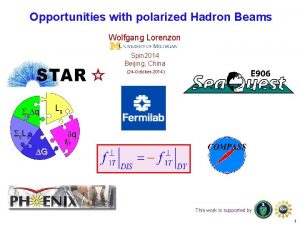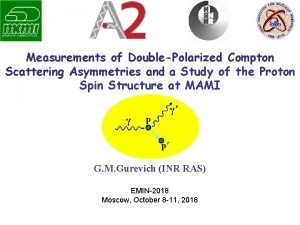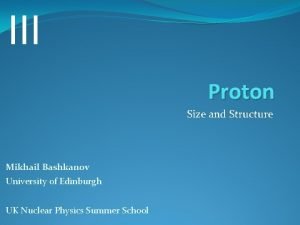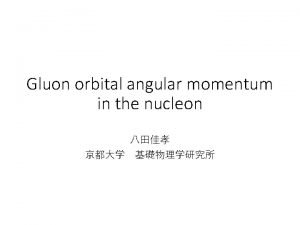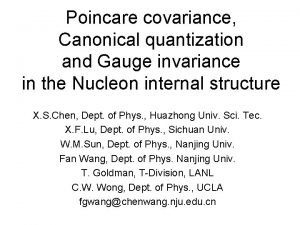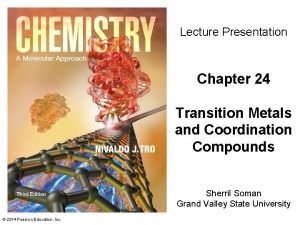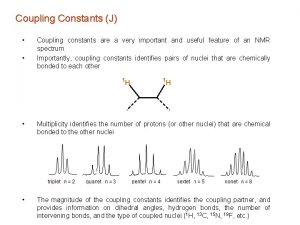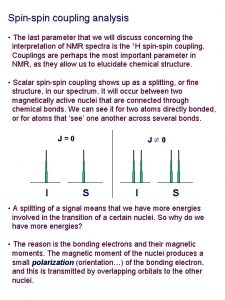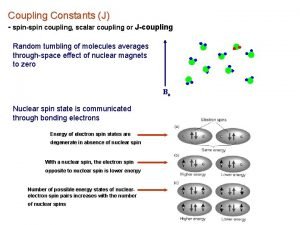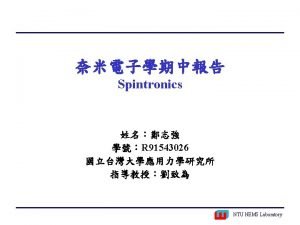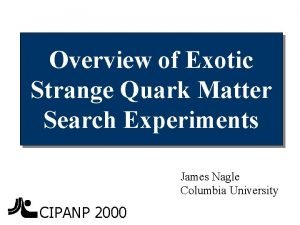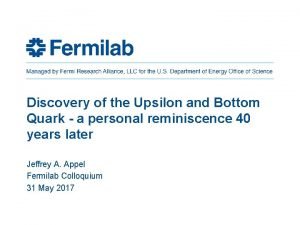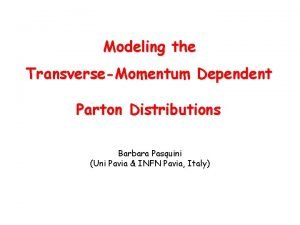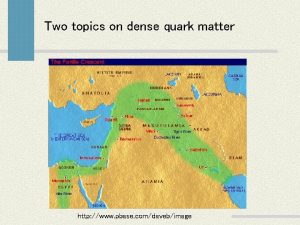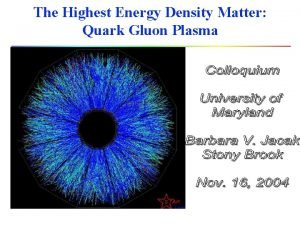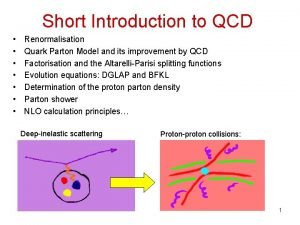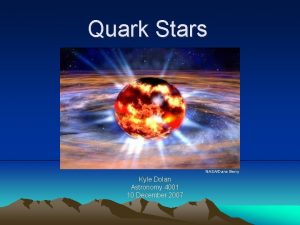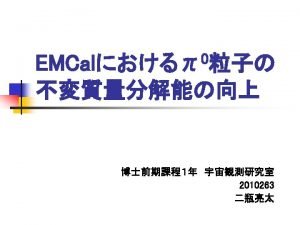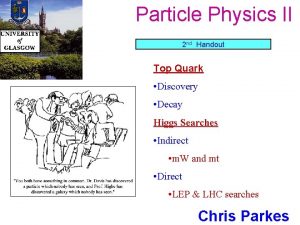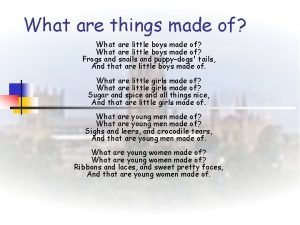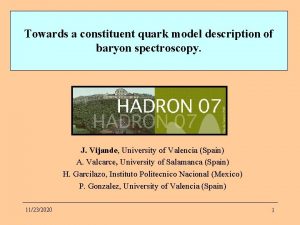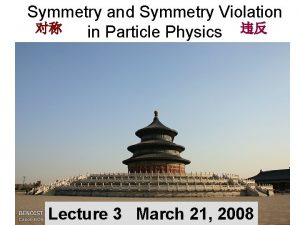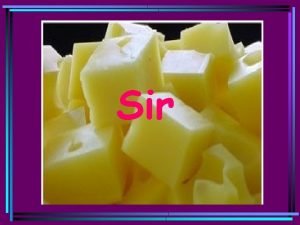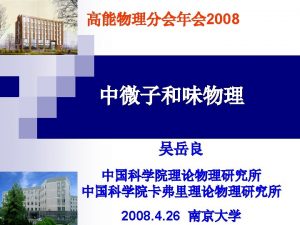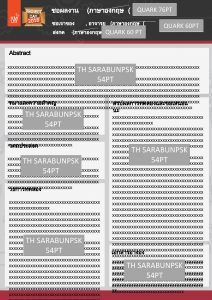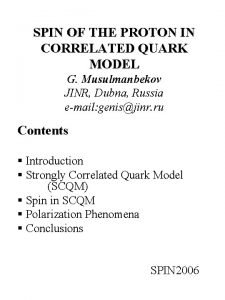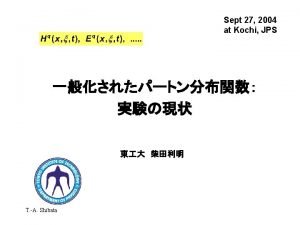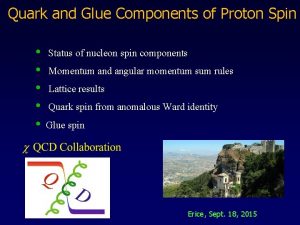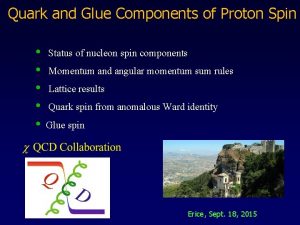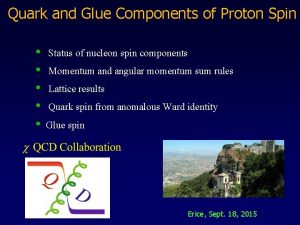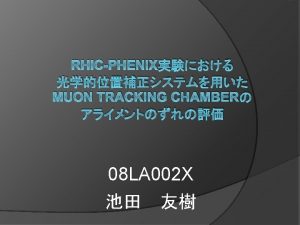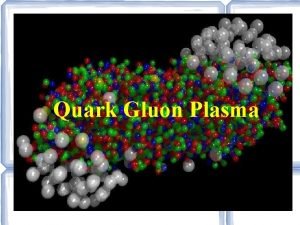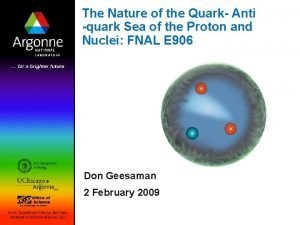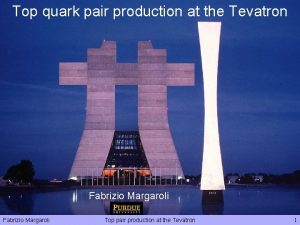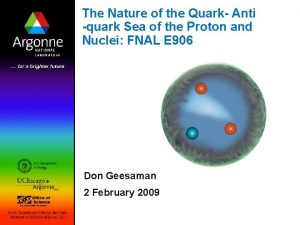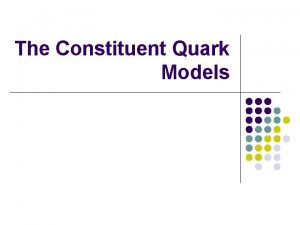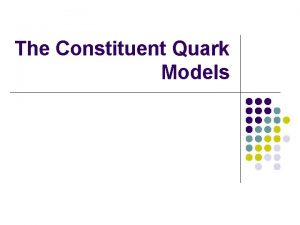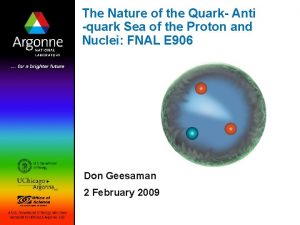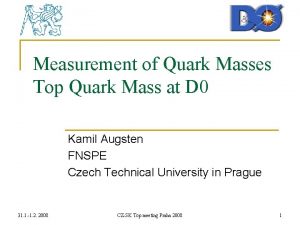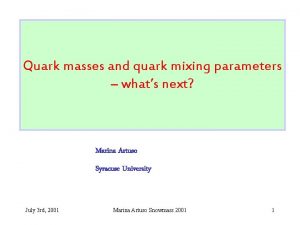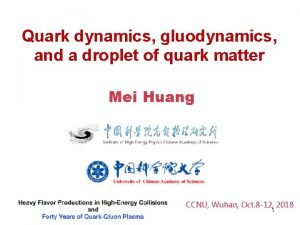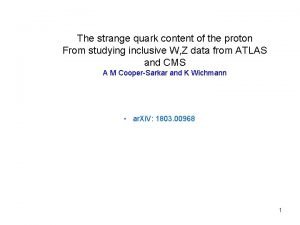Where does the proton spin come from Quark





























- Slides: 29

Where does the proton spin come from? • Quark and glue spins – status • Momentum and angular momentum sum rules • Lattice calculation χQCD Collaboration: M. Deka, T. Doi, B. Chakraborty, D. Mankame, S. J. Dong, T. Draper, M. Gong, H. W. Lin, K. F. Liu, N. Mathur, T. Streuer, Y. Yang Diffraction 2012, Sept. 12, 2012

2

See Talk 1193 by F. Kunne Horst Fischer DIS 2010 3

Quark Orbital Angular Momentum (connected insertion) 4

Status of Proton Spin • Quark spin ΔΣ ~ 20 - 30% of proton spin (DIS, Lattice) • Quark orbital angular momentum? (lattice calculation (LHPC, QCDSF) ~ 0) • Glue spin ΔG/G small (COMPASS, STAR) ? • Glue orbital angular momentum is small (Brodsky and Gardner) ? Dark Spin ? 5

Hadron Structure with Quarks and Glue • Quark and Glue Momentum and Angular Momentum in the Nucleon 6

Momenta and Angular Momenta of Quarks and Glue § Energy momentum tensor operators decomposed in quark and glue parts gauge invariantly --- Xiangdong Ji (1997) § Nucleon form factors § Momentum and Angular Momentum

T 1 (q 2) and T 2 (q 2) 3 -pt to 2 -pt function ratios Need both polarized and unpolarized nucleon and different kinematics (pi, qj, s) to separate out T 1 (q 2), T 2 (q 2) and T 3 (q 2)

Renormalization and Quark-Glue Mixing Momentum and Angular Momentum Sum Rules Mixing 9

Lattice Parameters • Q u e n c h e d 1 6 3 x 2 4 l a t t i c e wi t h W i l s o n ferm i o n • Q u a r k s p i n a n d < x> w e r e c a l c u l a t e d b e f o r b o t h e C. I. a n d D. I. • κ = 0. 154, 0. 1555 (mπ = 650, 5 3 8 , 4 7 8 M e. V ) • 5 0 0 co n fi g u ra t i o n s • 4 0 0 n o i s e s ( O p t i m a l Z 4 n o i s e w i t h u n b i a se d su b t r a c t i o n ) f o r DI • 1 6 n u c l eo n so u rc es 10

Connected Insertions of T 1 (q 2) and T 2 (q 2) for u/d Quarks cross check

Disconnected Insertions of T 1 (q 2) and T 2 (q 2) for u/d Quarks

Gauge Operators from the Overlap Dirac Operator Overlap operator Index theorem on the lattice (Hasenfratz, Laliena, Niedermayer, Lüscher) Local version (Kikukawa & Yamada, Adams, Fujikawa, Suzuki) Study of topological structure of the vacuum l Sub-dimensional long range order of coherent charges (Horvàth et al; Thacker talk in Lattice 2006) l Negativity of the local topological charge correlator (Horvàth et al)

We obtain the following result where, Liu, Alexandru, Horvath – PLB 659, 773 (2007) Noise estimation with Z 4 noise with color-spin dilution and some dilution in space-time as well.

Glue T 1 (q 2) and T 2 (q 2)

Renormalized results: Zq = 1. 05, Zg = 1. 05 CI(u) CI(d) CI(u+d) 0. 428 <x> (40) T 2(0) 0. 297 (112) 2 J DI(u/d) DI(s) Glue 0. 313 (56) -. 059 (52) 0. 156 (20) -. 218 (80) 0. 586 (45) 0. 064 (22) 0. 038 (6) -0. 002 (2) 0. 024 (6) -. 001 (3) 0. 726 -. 072 (128) (82) 0. 651 (51) 0. 036 (7) 0. 023 0. 254 (7) (76) S. Brodsky et al. NPB 593, 311(2001) → no anomalous gravitomagnetic moment E. Leader, ar. Xiv: 1109. 1230 → transverse angular momentum 16

<x> 0. 313 0. 58600000001 0. 024 0. 0760000 1 CI(u+d) DI(s) Glue 2 J 0. 254 0. 023 0. 072 CI(u+d) DI(s) Glue 0. 6510000001

Flavor-singlet g. A • Quark spin puzzle (dubbed `proton spin crisis’) – – NRQM – Experimentally (EMC, SMC, … 18

S. J. Dong, J. -F. Lagae, and KFL, PRL 75, 2096 (1995) • DI sea contribution independent of quark mass • This suggests U(1) anomaly at work. • 19

Lattice resolution: U(1) anomaly Lattice 0. 25(12) 1. 20(10) 0. 61(13) 0. 79(11) -. 42(11) -. 12(1) 0. 45(6) 0. 75(11) 0. 60(2) Expt. (SMC) NRQM 0. 22(10) 1 1. 2573(28) 5/3 0. 579(25) 1 0. 80(6) 1. 33 -0. 46(6) -0. 33 -0. 12(4) 0 0. 459(8) 0. 67 0. 798(8) 1 0. 575(16) 0. 67 RQM 0. 75 1. 25 0. 75 1 -0. 25 0 0. 5 0. 75 0. 67 20

Renormalized results: CI(u) CI(d) CI(u+d) 2 J g. A 2 L 0. 726 (128) 0. 95 (11) -0. 25 (18) DI(u/d) DI(s) Glue -. 072 (82) -0. 32 (12) 0. 651 (51) 0. 65 (8) 0. 036 (7) -0. 12 (1) 0. 023 0. 254 (7) (76) -0. 12 (1) 0. 26 (14) 0. 00 (10) 0. 17 (2) 0. 15 (2) 21

Quark Spin, Orbital Angular Momentum, and Gule Angular Momentum 0. 254 2 J Quark Spin Qurak OAM Glue AM 0. 49

Summary • Momentum fraction of quarks (both valence and sea) and glue have been calculated for a quenched lattice: – Glue momentum fraction is ~ 31%. – g. A 0 ~ 0. 25 in agreement with expt. – Glue angular momentum is ~ 25%. • Quark orbital angular momentum is large for the sea quarks (~ 50%). • These are quenched results so far. 23

Le Taureau of Pablo Picasso (1945) 5 th stage Dynamical fermion 11 th stage Quenched approximation with chiral symmetry and light quark masses ITP, 2005, page 24

Current project • Dynamical domain-wall fermion gauge • (RBC + UKQCD configurations, lowest pion mass ~ 180 Me. V on 4. 5 fm box) + overlap fermion for the valence. Quark loops with low mode averaging and improved nucleon propagator. 25

Talk by M. Gong page 26

The gauge-invariant “exclusive” approach X. S. Chen, T. Goldman, F. Wang, C. W. Wong et al. PRL 103: 062001 (2009); PRL 100: 232002 (2008) X. Ji 27

Recent Development on Glue Spin M. Wakamatsu § Decomposition of proton spin § One loop anomalous dimensions are shown to be gauge independent. E. Leader • No need to require the operator to be gauge invariant as long as the physical matrix element is. • Suggests that canonical form, e. g. the momentum operator is which involves a partial derivative. page 28

Subject E. Leader’s proposal to a test on the lattice H. W. Lin and K. F. Liu, PRD, [ar. Xiv: 1111. 0678] Calculation of nucleon three-point function with Elitzur’s theorem holds. page 29
 Proton proton chain
Proton proton chain Proton proton chain
Proton proton chain Proton proton chain
Proton proton chain Littleqm
Littleqm Proton spin
Proton spin Proton spin
Proton spin Proton spin
Proton spin Mikhail bashkanov
Mikhail bashkanov Proton spin
Proton spin Proton spin crisis
Proton spin crisis Low spin and high spin complex
Low spin and high spin complex Spin-spin coupling examples
Spin-spin coupling examples Spin spin coupling
Spin spin coupling J coupling constant
J coupling constant 優點
優點 Come rico
Come rico Particle wordle
Particle wordle Quarks
Quarks Quark names
Quark names Quark model
Quark model Quark gluon
Quark gluon Quark gluon
Quark gluon Quark parton model
Quark parton model Quark astronomy
Quark astronomy Quark gluon plasma
Quark gluon plasma Top quark decay
Top quark decay Quark names
Quark names Constituent quark model
Constituent quark model A charm quark has a charge of approximately
A charm quark has a charge of approximately Zamjena za kačkavalj sir
Zamjena za kačkavalj sir
